The joint between the wall and the ceiling is most often finished using a ceiling plinth ...
|
|
Bitumen cheap waterproofing and adhesive material, which is often used in ... |
The efficiency of heating of any object of residential or industrial purposes is possible with ... |
Do -it -yourself thunderclap
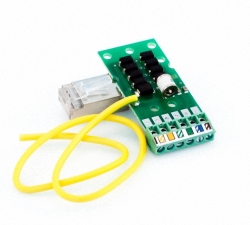
During a thunderstorm, in order to improve the safety of houses and people who live there, it is recommended to install a system with thunderstorm protection of the system. There are special services that deal with this issue, but if you want to carry out the installation of thunderclap with your own hands, we recommend that you familiarize yourself with this article.
Table of contents:
- The principle of operation of thunderstorms
- Methods of thunder protection of buildings
- Rules for calculating thunderstorms
- Recommendations for improving buildings safety during a thunderstorm
- Indoor thunderclap device
- Requirements for the main components of thunderstorms
- Methods of attaching cables or wires of lightning recreation
The principle of operation of thunderstorms
Ground lightning, which easily fall into objects located on Earth, pose a great danger, both for a person and his home, because lightning stress is millions and even billions of volts.
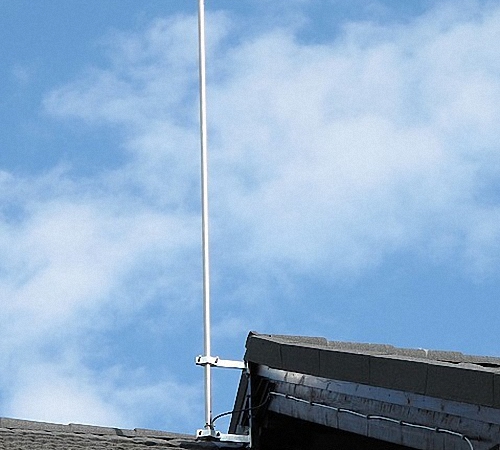
Complex thunderstorm consists of two components: external and internal. The external component of thunderstorms, with a lightning strike, intercepts and removes energy to the ground, and the internal thunderclap is a connector of all electric networks located inside the room, and creates the so -called ground.
The main parts of external thunderstorms:
- lightning rod,
- Tokoowood,
- Group.
The functional feature of the lightning rod is interception of lightning. Varieties of lightning rods: a rod located on the roof skate, a thunderbate in the form of a mesh is used for a flat roof, another version of lightning rod - a cable that is pulled above the building.
Tokoodes are mounted on the walls of the house. The main feature of the installation of current -wilness is the shortest way from lightning rod to the ground so that lightning gets into the grounding holder faster.
The grounding conductor is used to transfer current to the ground.
Internal lightning protection of the house is the protection of the wiring from sharp voltage leaps that provokes lightning.
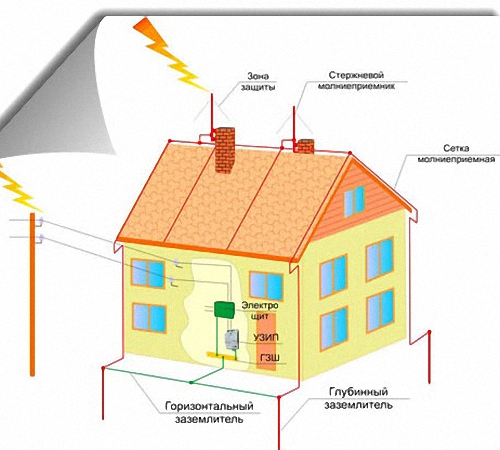
Methods of thunder protection of buildings
According to mathematical modeling, the most reliable way to protect the house from a lightning entering is a grid that is pulled over the entire surface of the roof, at a height of one to one and a half meters.
Installation of a metal pin, which is several times higher than the height of the building is also a good option.
In the presence of a metal roof, which has a thickness of more than 10 mm, it is possible to connect grounding to the roof in several places, so the roof will play the role of lightning rod, and grounding will take a lightning strike and transmit current to the ground.
With a swept roof, it is permissible to install a metal cable that is pulled above the roof at a height of 0.5 to 1.5 m.
For more complex roofs, the cable is pulled in several places, in places of skates or other metal parts.
For a flat roof-the best option is a stretched mesh made of a metal cable, which has a distance of cells of one or two meters, also for such a roof is a pin three to four meters long, which is installed in the middle of the roof.
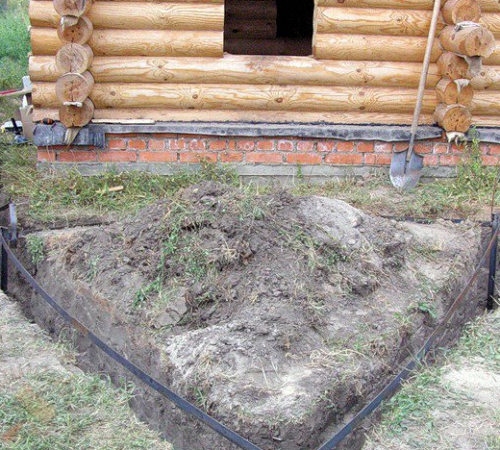
Rules for calculating thunderstorms
To be sure that the building is really protected from lightning, you must definitely calculate lightning protection. The calculation of lightning protection depends on the following indicators:
- Type of building: rectangle, square, oval or circle;
- The dimensions of the building: width, height and length;
- the presence of additional outbuildings, arbors or separate buildings;
- the number of thunderstorms in one year, for 1 km;
- The likelihood of a zipper in this site.
Lightning protection is divided into several categories. The most suitable for residential buildings is the third category of lightning protection. Before starting the calculation, decide on the type of building. For example, consider the calculation of a single rod lightning protection for the building, in the form of a circular cone.
The length of the building is designated by the letter A, width B, and the height of HX. Suppose the width of the building is 25 m, the length is 18 m, and the height is 7 m. Now it is necessary, using a special card, find out about annual quantities (N) and the average duration (t) thunderstorms, in the territory of this building.
N \u003d (B+6h) (a+6h) -7h2) n10-5
After the calculation, we get n \u003d 0.0134353. The number of lightning lesions per year. Depending on the reliability of lightning protection, two areas are distinguished: a - more than 99.5%; B - from 95% to 99.5%.
Depending on the quantity and average duration of the thunderstorm, we determine the zone of this building and calculate the height of the lightning rod. It is better to entrust this process to specialists, since the correct calculation of lightning rod will ensure the safety of the building for many years.
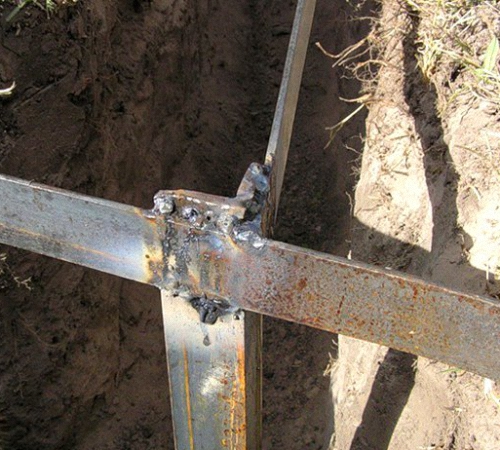
Recommendations for improving buildings safety during a thunderstorm
1. When installing high -altitude structures of thunderclap, it is necessary to carry out thorough fixing so that under the influence of wind, these parts do not come off or damage the nearest buildings or cars, and also do not injure people.
2. In the presence of metal or brick pipes on the roof of the building, it is necessary to ground metal pipes and install metal pins for brick.
3. Install ground for television or satellite antennas, because these devices are connected to electricity and easily attract lightning during a thunderstorm.
4. Before the start of the season, the thunderstorms need to be carried out a thorough inspection of the lightning rod and other components of the thunderstorm system.
5. During a thunderstorm, it is recommended to close all the windows, doors and windows to prevent ball lightning from getting into the room.
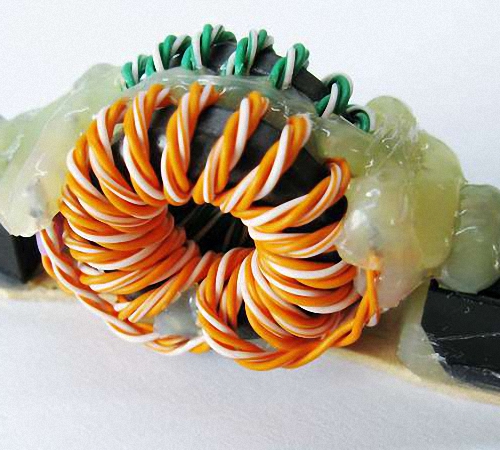
Indoor thunderclap device
Uzip - a protection device against internal overvoltage - the main component of the internal protection of the building during a thunderstorm. The Uzip device is a module of lightning protection, which is made on the basis of variastor or discharge.
Depending on the protection class, all Uzip devices are divided into:
1. Uzip of the first class, which are installed in front of the camshaft. Such devices easily stop high -power discharges and extinguish current.
2. Uzip of the second class are designed to protect electrical appliances from a residual pulse. They are installed in buildings where server or ordinary networks are located, to which various equipment are connected.
3. The third-class Uzipes protect low-current systems, such as telephone, Internet system or video surveillance camera.
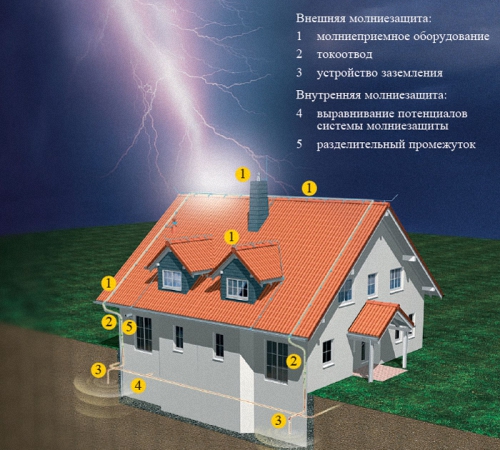
Requirements for the main components of thunderstorms
Before starting work on the installation of thunderstorms, we will get acquainted with the basic requirements for components of external thunderstorms:
1. Requirements for lightning rod: the greatest height among all objects located in the territory.
2. Requirements for the conductor of lightning protection: minimum length, high level of insulation for good current passage, when installing the conductor, avoid the presence of joints or twists, it is better to use welding or soldering, use steel tapes or rods as a conductor that have a small diameter.
3. Requirements for the grounding conductor: location of at least four meters from the foundation, high soil humidity.
Thunderstorm circuit:
Tools for installing external core lightning protection:
- Lightning receiver,
- Tokoowood,
- grounding electr
- welding machine,
- Metal brackets or clamps.
Instructions for the installation of thunderstorms:
1. Install the rod metal receiver. Connect to it a current that consists of a metal wire with a round section. The current should have a minimum length for a faster transmission of current from the metal receiver to the grounding ground.
2. Use a metal strip or a metal plate with a cross section of at least 150 cm as a grounding conductor.
3. Using bolts and electric welding, combine all the elements of this system among themselves.
Grounding installation:
The most important rule for installing grounding is the provision of constant soil humidity. There are two options to fulfill this requirement:
- installation of grounding at the place of passage of groundwater;
- The installation of grounding is below the freezing of the soil, but at the same time it is necessary to supply water flow from the roof to the installation site of the grounding ground.
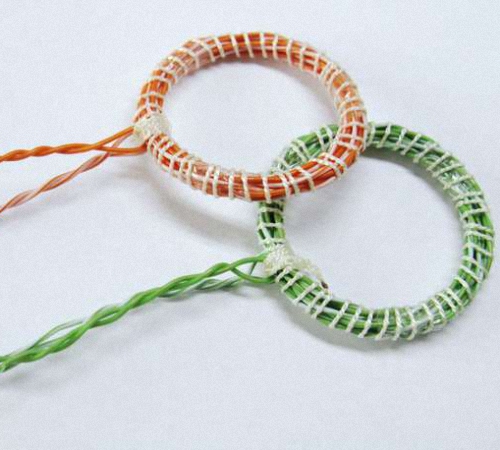
Use a piece of iron, a metal barrel, a pipe, a corner of a leaf or rod that must be scored into the ground. The pipe, rod or corner differs in a small area, so it is recommended to cook them from several parts, for example, in the form of an inverted letter S.
Consider one of the grounding options: a 1 m metal sheet must be buried in the ground, having previously prepared a hole that reaches groundwater, the minimum depth of the pit is two meters. When choosing a grounding material, it is better to use high -quality galvanized metal, copper, aluminum or duralumin, since ordinary iron rotates over time, and grounding will not perform its functions. The connection of the underestimation with ground is carried out by welding or screwing the grounding ground to the steel strip or cable.
Make sure that the grounding is not near the well, pool or drinking well.
To underestimate, an excellent option would be a steel conductor, which has a cross section of 10*10 cm or a metal strip with a width of 40 mm, and a thickness of 25 mm. Lay under the wall of the building without additional isolation. The cable must be welded with electric welding or joined with bolts.

Methods of attaching cables or wires of lightning recreation
Distinguish:
- stretch system of mounting;
- Remote mounting system.
To install the lightning receiver with a stretch method, hard anchors are installed on the arrow -shaped roof and walls of the building and the wires are pulled. The fastening of wires or cable is carried out using special clamps.
When using a self -binding angular clamp and dowels, the cable is mounted on a flat roof. If the roof is too steep, instead of an angular clamp, a skate is used, which allows you to choose color and texture, according to the general design of the roof.
Tips for the installation of thunderstorms:
1. For calculating thunderstorms, it is not necessary to calculate all the indications according to the above formula, there are online calculators that will cope with this task much faster. But the indications of the size of the building and the annual number of lightning blows still need to be recognized and measured.
2. In the presence of a large tree on the territory of the house, fix the lightning receiver on the tree with the help of a pole and clamps. A prerequisite for such thunderstorms of such a lightning receiver above the top of the tree. Do not use metal bolts to fix the lightning receiver on a tree to avoid damage or fire.
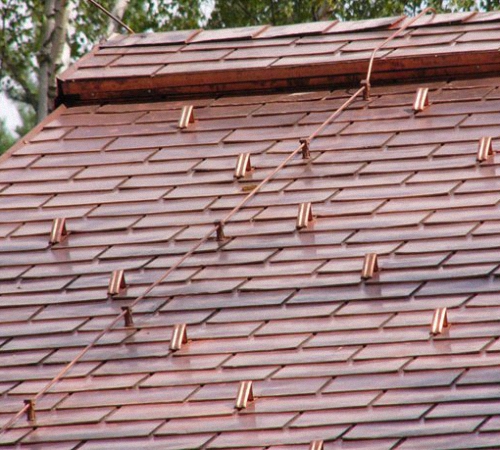
3. In the presence of a television mast, place the lightning receiver on it, and if the mast is metal and not painted, then it will be a good current wir.
4. The chimney is a good place to attach lightning rod. Attach the lightning rod to the chimney, but keep in mind that with a strong wind too much lightning rifle will damage the pipe, so before using this option, compare the size of the pipe and lightning rod.
5. It is allowed to use objects such as the back from the old metal bed, a reinforcing mesh or unnecessary metal objects as a grounding conductor.
6. When installing lightning protection, it is necessary to drill several holes in the ground and fill salt or nitrate there, since these materials contribute to an increase in the effect of current conduction.
7. When choosing a cable for grounding, it is recommended to use a cable with the highest section.
8. It is strictly forbidden to insulate or painting lightning.
9. You can not place a grounding ground near the walls of the building, paths or transition passages.
10. To connect a lightning and current -wilter, use copper, brass or galvanized screw clamps.
11. Repair and adjustment of the lightning protection system should be carried out at least once every three years. To do this, clean all contacts, pull up or replace the connections.
12. Once every five years, open the grounding and check the reliability of the compounds. In the presence of a large amount of rust, it is recommended to replace the ground electrode.
13. When choosing a current wiring, keep in mind that the material from which this part should withstand the load up to 200,000 amperes.
14. It is forbidden to bend current -wores, as the risk of fire is possible.

If you fall asleep salt or
If you fall asleep salt or silver, the earter oxidation will occur and its service life will decrease.
PUE says that inspection
It is written in the PUE that the inspection of grounding grounds with a partial excavation of the soil must be carried out once every 12 years you write (once every five years, open the grounding and check the reliability of the compounds. In the presence of a large amount of rust, it is recommended to replace the grounding ground.)
At least 6 mm in 2. You write
At least 6 mm in 2. Do you write (7. When choosing a cable for grounding, it is recommended to use a cable with the highest cross section.) All the same, what kind of cable section to choose?
Another sensible site about
Another sensible site about lightning protection: m-zevs.ru
Why are you writing any
Why are you writing any senseless garbage here, for example, "a conductor with a cross section of 10*10 cm"?